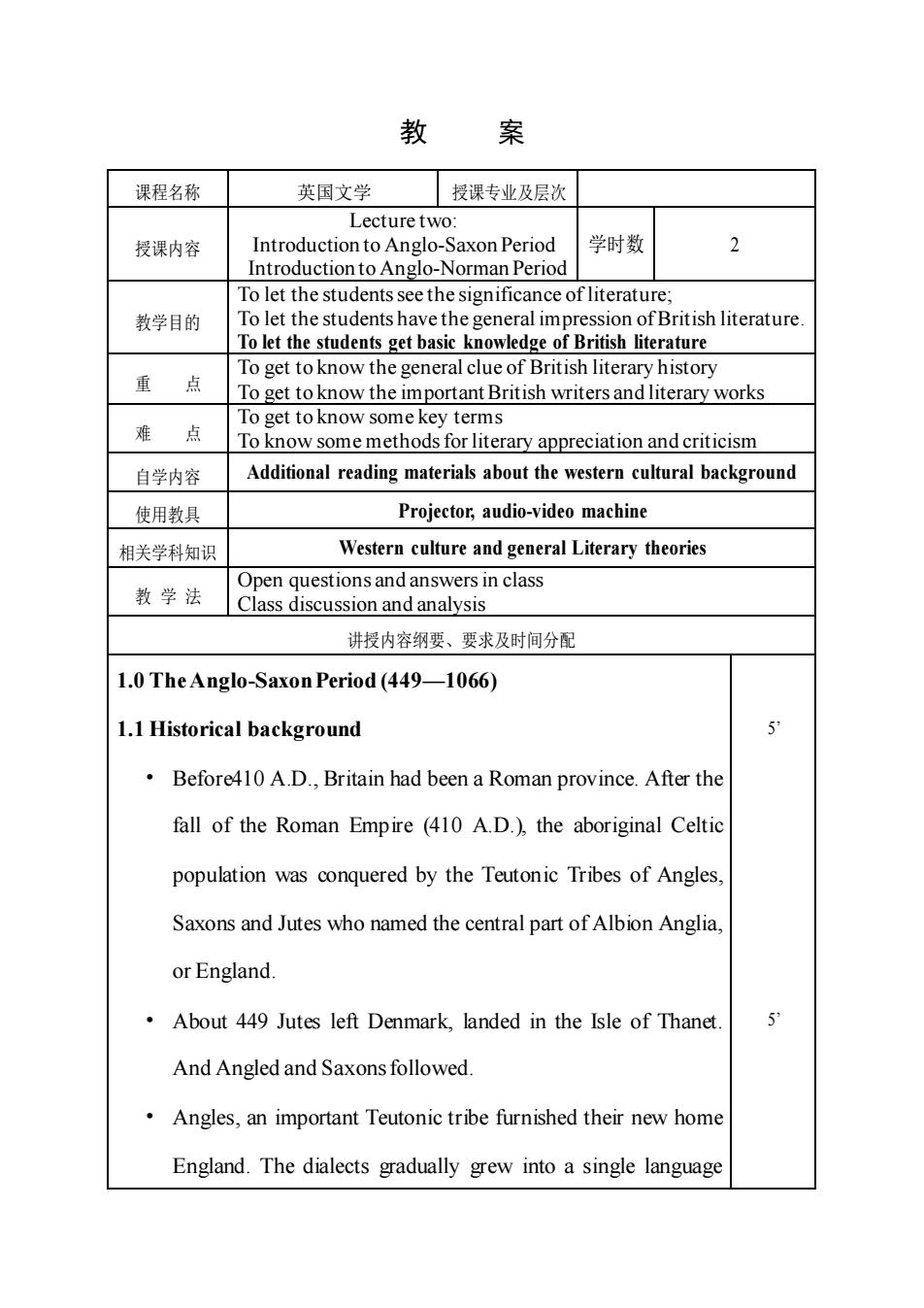
教 案 课程名称 英国文学 授课专业及层次 Lecture two: 授课内容 Introduction to Anglo-Saxon Period 学时数 Introduction to Anglo-Norman Period To let the students see the significance of literature 教学目的 To let the students get basic knowledge of British literature To get to know the general clue of British literary history 重点 To get to know the important British writers and literary works 难点 自学内容 Additional reading materials about the western cultural background 使用教具 Projector,audio-video machine 相关学科知识 Western culture and general Literary theories Open questions and answers in class 教学法Class 讲授内容纲要、要求及时间分配 1.0 TheAnglo-Saxon Period(449-1066) 1.1 Historical background 5 Before410 A.D.,Britain had been a Roman province.After the fall of the Roman Empire (410 A.D.),the aboriginal Celtic population was conquered by the Teutonic Tribes of Angles Saxons and Jutes who named the central part of Albion Anglia or England. About 449 Jutes left Denmark,landed in the Isle of Thanet. 5 And Angled and Saxons followed. Angles,an important Teutonic tribe furnished their new home England.The dialects gradually grew into a single language
教 案 课程名称 英国文学 授课专业及层次 授课内容 Lecture two: Introduction to Anglo-Saxon Period Introduction to Anglo-Norman Period 学时数 2 教学目的 To let the students see the significance of literature; To let the students have the general impression of British literature. To let the students get basic knowledge of British literature 重 点 To get to know the general clue of British literary history To get to know the important British writers and literary works 难 点 To get to know some key terms To know some methods for literary appreciation and criticism 自学内容 Additional reading materials about the western cultural background 使用教具 Projector, audio-video machine 相关学科知识 Western culture and general Literary theories 教 学 法 Open questions and answers in class Class discussion and analysis 讲授内容纲要、要求及时间分配 1.0 The Anglo-Saxon Period (449—1066) 1.1 Historical background • Before410 A.D., Britain had been a Roman province. After the fall of the Roman Empire (410 A.D.), the aboriginal Celtic population was conquered by the Teutonic Tribes of Angles, Saxons and Jutes who named the central part of Albion Anglia, or England. • About 449 Jutes left Denmark, landed in the Isle of Thanet. And Angled and Saxons followed. • Angles, an important Teutonic tribe furnished their new home England. The dialects gradually grew into a single language 5’ 5’
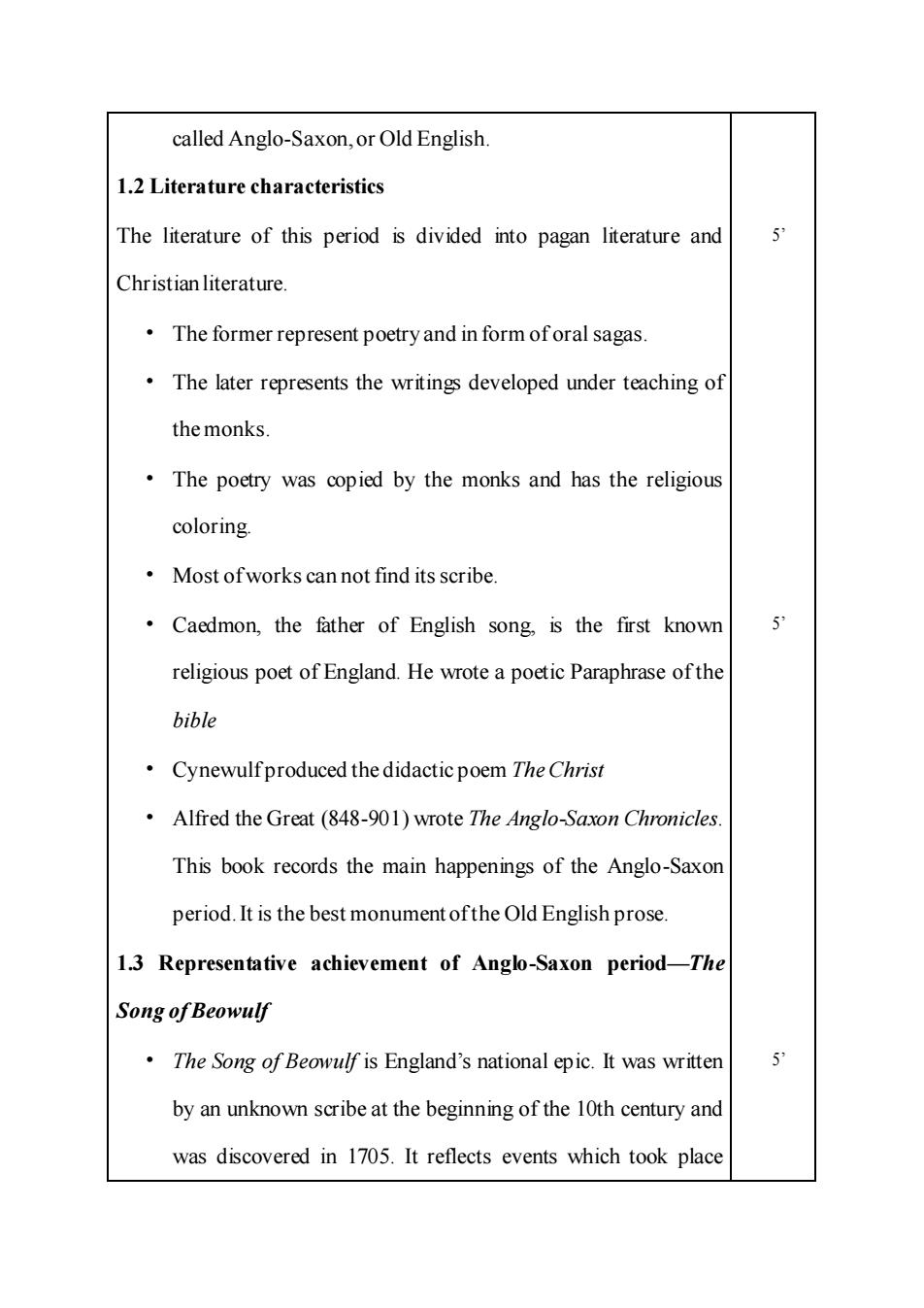
called Anglo-Saxon,or Old English 1.2 Literature characteristics The literature of this period is divided into pagan literature and 5 Christian literature. The former represent poetry and in form oforal sagas. The later represents the writings developed under teaching of the monks. The poetry was copied by the monks and has the religious coloring. Most of works can not find its scribe. Caedmon,the father of English song.is the first known 5 religious poet of England.He wrote a poetic Paraphrase ofthe bible Cynewulfproduced the didactic poem The Christ Alfred the Great (848-901)wrote The Anglo-Saxon Chronicles. This book records the main happenings of the Anglo-Saxon period.It is the best monument ofthe Old English prose. 1.3 Representative achievement of Anglo-Saxon period-The Song of Beowulf The Song of Beowulf is England's national epic.It was written 5 by an unknown scribe at the beginning of the 10th century and was discovered in 1705.It reflects events which took place
called Anglo-Saxon, or Old English. 1.2 Literature characteristics The literature of this period is divided into pagan literature and Christian literature. • The former represent poetry and in form of oral sagas. • The later represents the writings developed under teaching of the monks. • The poetry was copied by the monks and has the religious coloring. • Most of works can not find its scribe. • Caedmon, the father of English song, is the first known religious poet of England. He wrote a poetic Paraphrase of the bible • Cynewulf produced the didactic poem The Christ • Alfred the Great (848-901) wrote The Anglo-Saxon Chronicles. This book records the main happenings of the Anglo-Saxon period. It is the best monument of the Old English prose. 1.3 Representative achievement of Anglo-Saxon period—The Song of Beowulf • The Song of Beowulf is England’s national epic. It was written by an unknown scribe at the beginning of the 10th century and was discovered in 1705. It reflects events which took place 5’ 5’ 5’
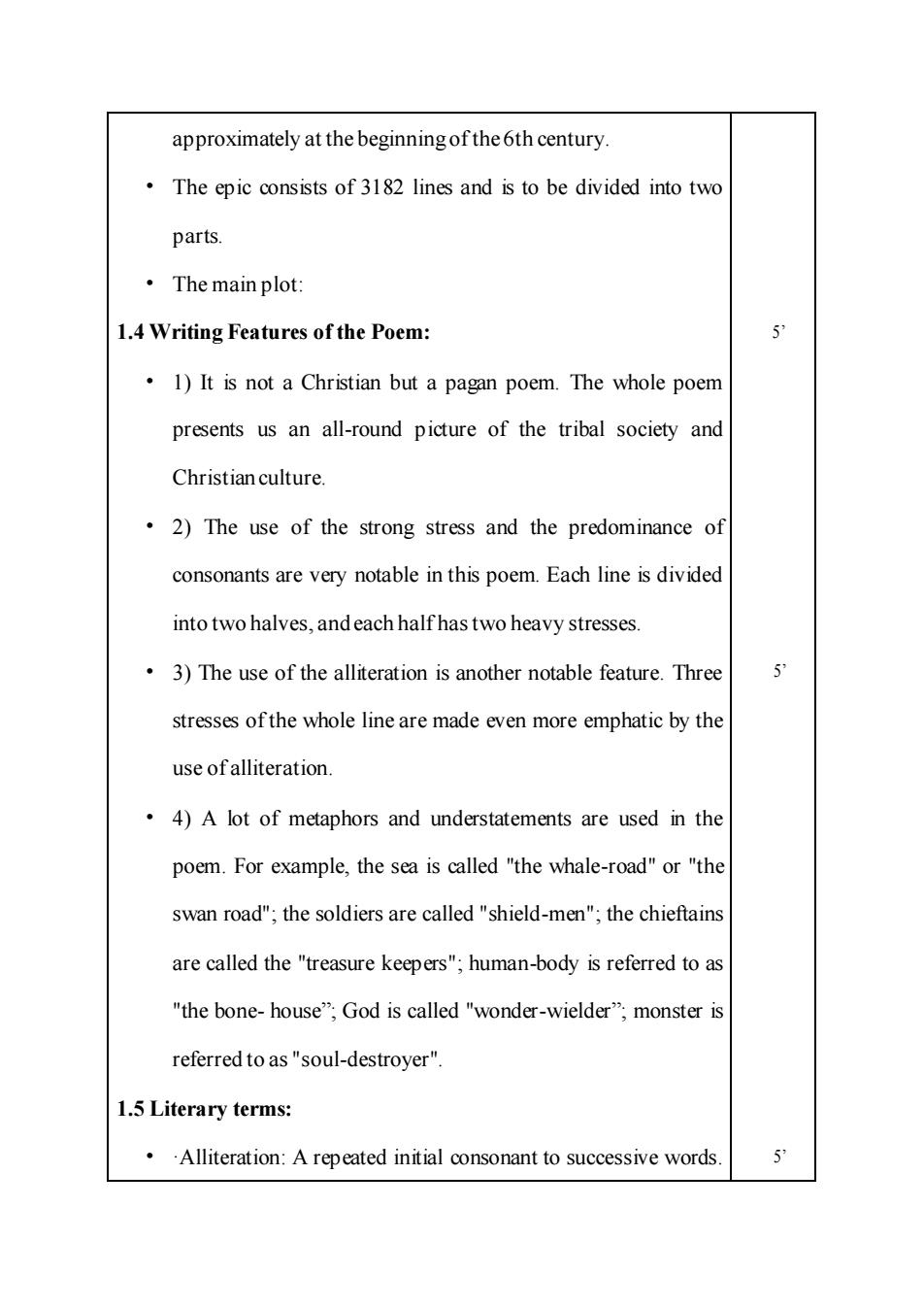
approximately at the beginning of the 6th century. The epic consists of 3182 lines and is to be divided into two parts. ·The main plot 1.4 Writing Features of the Poem: 1)It is not a Christian but a pagan poem.The whole poem presents us an all-round picture of the tribal society and Christian culture. .2)The use of the strong stress and the predominance of consonants are very notable in this poem.Each line is divided into two halves,andeach half has two heavy stresses. .3)The use of the alliteration is another notable feature.Three stresses of the whole line are made even more emphatic by the use ofalliteration. .4)A lot of metaphors and understatements are used in the poem.For example,the sea is called "the whale-road"or "the swan road";the soldiers are called"shield-men";the chieftains are called the "treasure keepers";human-body is referred to as "the bone-house";God is called "wonder-wielder";monster is referred to as"soul-destroyer" 1.5 Literary terms: .Alliteration:A repeated initial consonant to successive words
approximately at the beginning of the 6th century. • The epic consists of 3182 lines and is to be divided into two parts. • The main plot: 1.4 Writing Features of the Poem: • 1) It is not a Christian but a pagan poem. The whole poem presents us an all-round picture of the tribal society and Christian culture. • 2) The use of the strong stress and the predominance of consonants are very notable in this poem. Each line is divided into two halves, and each half has two heavy stresses. • 3) The use of the alliteration is another notable feature. Three stresses of the whole line are made even more emphatic by the use of alliteration. • 4) A lot of metaphors and understatements are used in the poem. For example, the sea is called "the whale-road" or "the swan road"; the soldiers are called "shield-men"; the chieftains are called the "treasure keepers"; human-body is referred to as "the bone- house”; God is called "wonder-wielder”; monster is referred to as "soul-destroyer". 1.5 Literary terms: • ·Alliteration: A repeated initial consonant to successive words. 5’ 5’ 5’
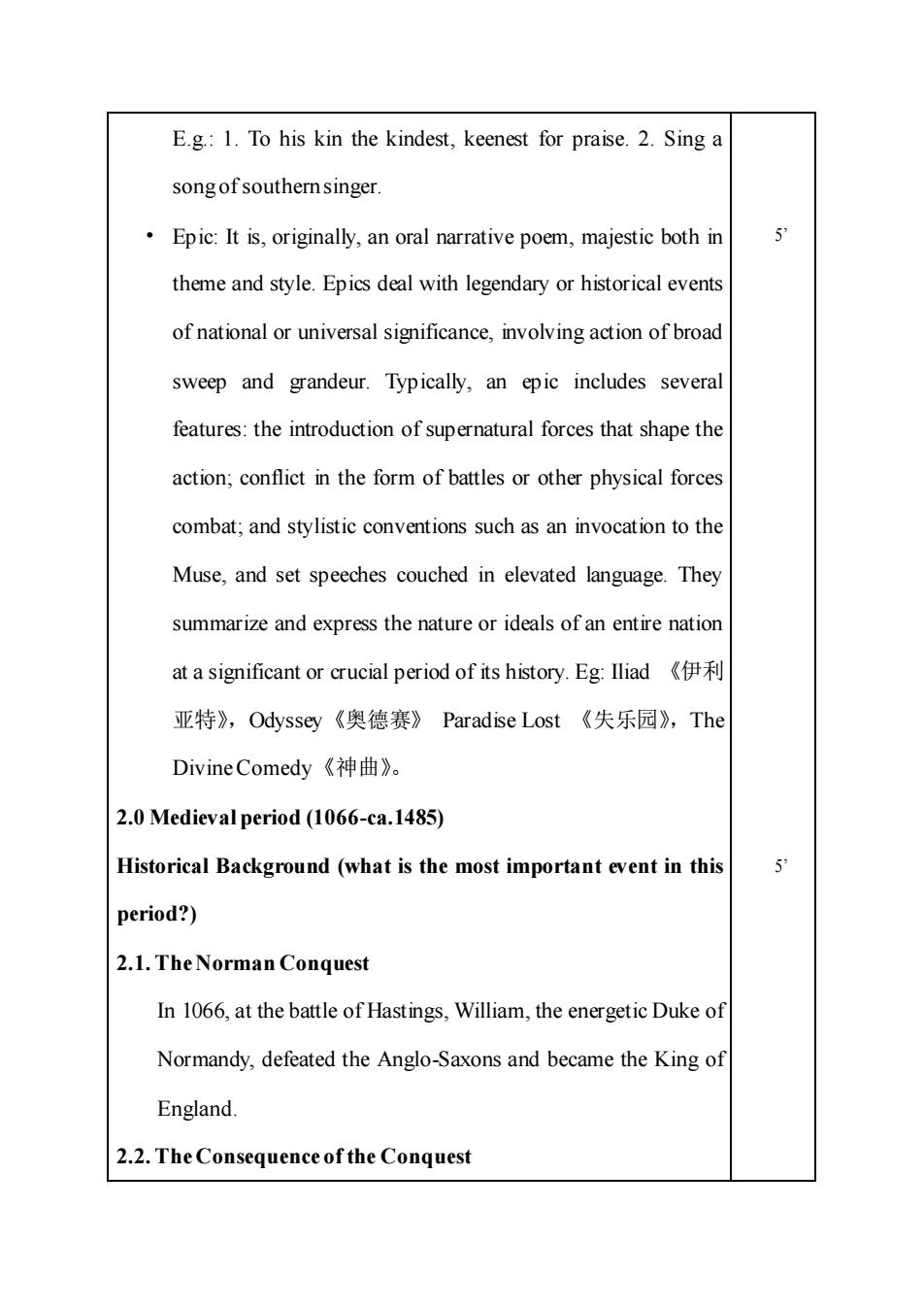
E.g.:1.To his kin the kindest,keenest for praise.2.Sing a song of southern singer. Epic:It is,originally,an oral narrative poem,majestic both in theme and style.Epics deal with legendary or historical events of national or universal significance,involving action of broad sweep and grandeur.Typically,an epic includes several features:the introduction of supernatural forces that shape the action;conflict in the form of battles or other physical forces combat,and stylistic conventions such as an invocation to the Muse,and set speeches couched in elevated language.They summarize and express the nature or ideals of an entire nation at a significant or crucial period of its history.Eg:liad《伊利 亚特》,Odyssey《奥德赛》Paradise Lost《失乐园》,The Divine Comedy《神曲》。 2.0 Medieval period(1066-ca.1485) Historical Background (what is the most important event in this 5 period?) 2.1.The Norman Conquest In 1066,at the battle of Hastings,William,the energetic Duke of Normandy,defeated the Anglo-Saxons and became the King of England. 2.2.The Consequence of the Conquest
E.g.: 1. To his kin the kindest, keenest for praise. 2. Sing a song of southern singer. • Epic: It is, originally, an oral narrative poem, majestic both in theme and style. Epics deal with legendary or historical events of national or universal significance, involving action of broad sweep and grandeur. Typically, an epic includes several features: the introduction of supernatural forces that shape the action; conflict in the form of battles or other physical forces combat; and stylistic conventions such as an invocation to the Muse, and set speeches couched in elevated language. They summarize and express the nature or ideals of an entire nation at a significant or crucial period of its history. Eg: Iliad 《伊利 亚特》,Odyssey《奥德赛》 Paradise Lost 《失乐园》,The Divine Comedy《神曲》。 2.0 Medieval period (1066-ca.1485) Historical Background (what is the most important event in this period?) 2.1. The Norman Conquest In 1066, at the battle of Hastings, William, the energetic Duke of Normandy, defeated the Anglo-Saxons and became the King of England. 2.2. The Consequence of the Conquest 5’ 5’
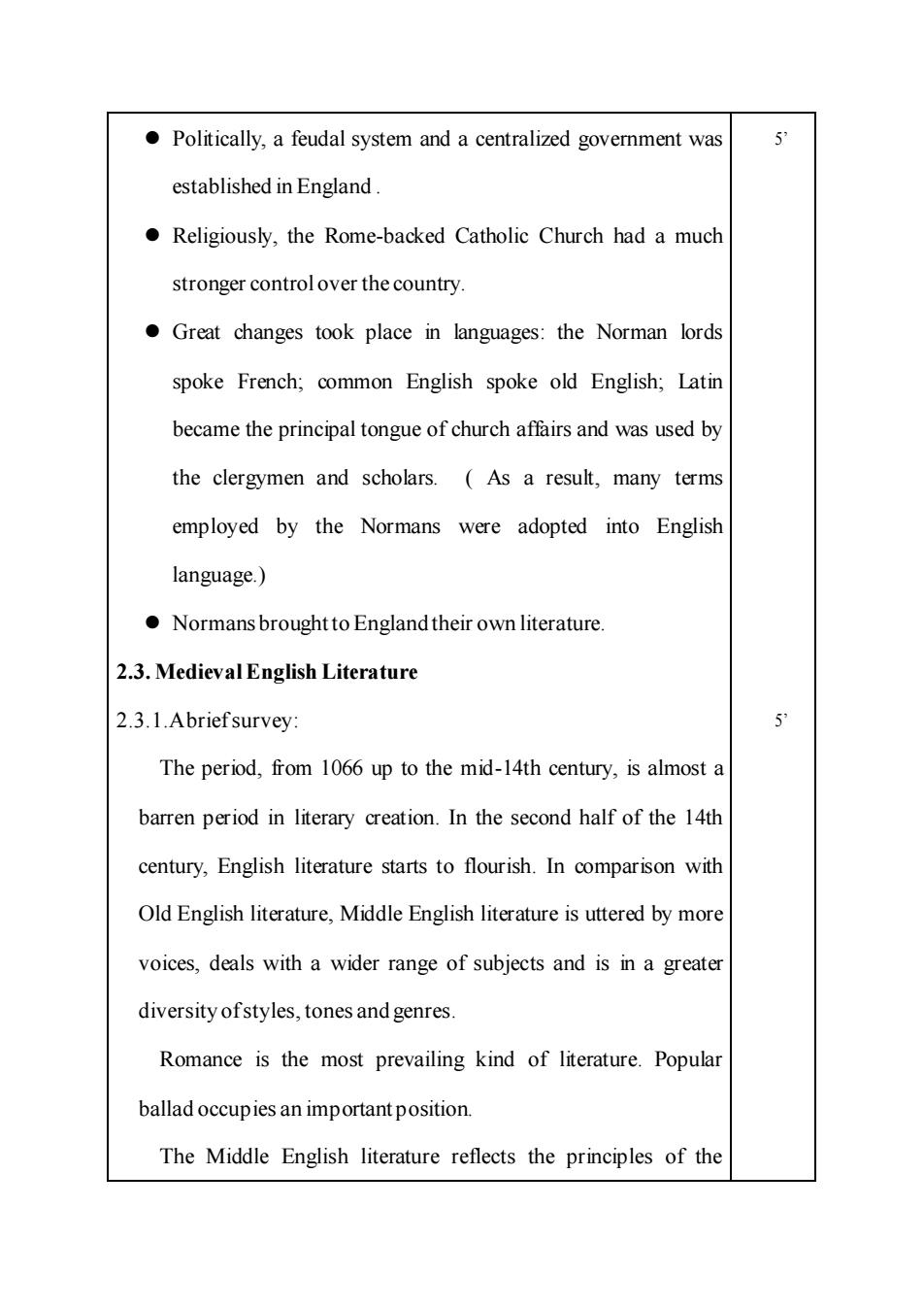
Politically,a feudal system and a centralized government was 5 established in England. Religiously,the Rome-backed Catholic Church had a much stronger control over the country Great changes took place in languages:the Norman lords spoke French;common English spoke old English;Latin became the principal tongue of church affairs and was used by the clergymen and scholars.As a result,many terms employed by the Normans were adopted into English language.) Normans brought to England their own literature. 2.3.Medieval English Literature 2.3.1.Abriefsurvey: 5 The period,from 1066 up to the mid-14th century,is almost a barren period in literary creation.In the second half of the 14th century,English literature starts to flourish.In comparison with Old English literature,Middle English literature is uttered by more voices,deals with a wider range of subjects and is in a greater diversity ofstyles,tones and genres. Romance is the most prevailing kind of literature.Popular ballad occupies an important position. The Middle English literature reflects the principles of the
⚫ Politically, a feudal system and a centralized government was established in England . ⚫ Religiously, the Rome-backed Catholic Church had a much stronger control over the country. ⚫ Great changes took place in languages: the Norman lords spoke French; common English spoke old English; Latin became the principal tongue of church affairs and was used by the clergymen and scholars. ( As a result, many terms employed by the Normans were adopted into English language.) ⚫ Normans brought to England their own literature. 2.3. Medieval English Literature 2.3.1.A brief survey: The period, from 1066 up to the mid-14th century, is almost a barren period in literary creation. In the second half of the 14th century, English literature starts to flourish. In comparison with Old English literature, Middle English literature is uttered by more voices, deals with a wider range of subjects and is in a greater diversity of styles, tones and genres. Romance is the most prevailing kind of literature. Popular ballad occupies an important position. The Middle English literature reflects the principles of the 5’ 5’